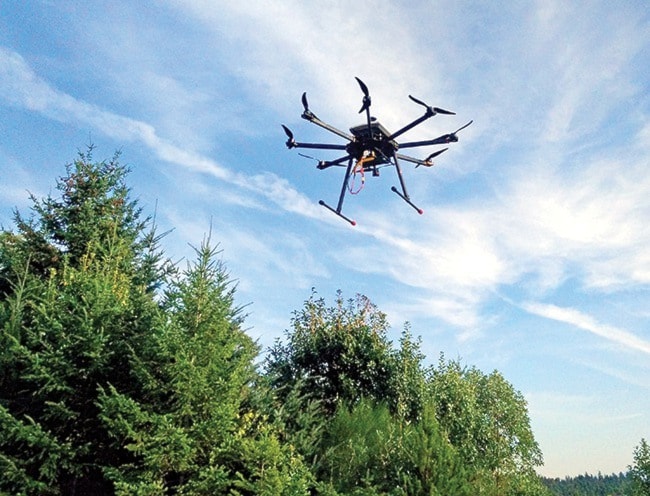Dashwood based Aretas Aerial has released its latest UAV — unmanned aerial vehicle, known as drones — for commercial, industrial and research applications.
"The Canadian built UAV Octocopter V1000 Drone is designed for technical payloads and provides a steady, reliable flight platform," said Aretas' Greg Duerksen by e-mail.
"Taking advantage of the newest high power motors and carbon fibre propellers, the large octocopter platform can carry a heavy payload such as a cinema quality DSLR camera, scanning LiDAR and radiation sensors," he said.
Aretas started as a wireless sensor company developing web-connected and remote sensors and software for things like carbon dioxide or radiation and smart building technology.
From there they expanded into drones as a natural extension, Duerksen previously explained, providing another platform for their sensors.
Last winter they began selling drones to fire departments complete with high definition video and thermal imagery to help see people or hot sports through smoke, trees or buildings.
In one of the first flights, for the Mackenzie, B.C. fire department, a UAV flew over a hog-fuel (wood chip) pile of concern showing representatives on the ground stress cracks and hot spots they couldn't have seen any other way.
"Already in its first flight, the UAV has proven to be an invaluable piece of equipment," said Deputy Chief Keinan Carty.
A company representative previously said their fire fighting drone package costs about the same $10,000 fire departments spend on a single handheld infrared camera.
The new V1000 is the first multirotor drone in Aretas' lineup which — along with its' vertical take-off and landing — allows it to be parked at a fixed GPS location and/or altitude to monitor one spot, unlike fixed wing aircraft.
The drone can be purchased with a wide variety of monitoring and sensing equipment which provide real-time data online.
“This UAV, at almost five feet in diameter, has a large payload area which allows significant space for payload customization,” Duerksen said, adding it can “tolerate a motor, propeller or speed controller failure while maintaining flight and safety of the payload.”
He’d previously said possible could include flying along pipelines “smelling” for leaks, finding people in remote areas and dropping an emergency package while they are being rescued, or monitoring unstable nuclear power plants.
“We’re basically selling flying robots,” Duerksen said, admitting the complexities, adding they have their own training programs for customers and work with them on safe use.
While he admitted enforcement is sometimes an issue, Duerksen said Transport Canada does have UAV regulations, with different weight categories determining the level of certification required.
Visit www.aretasaerial.com for more information.
